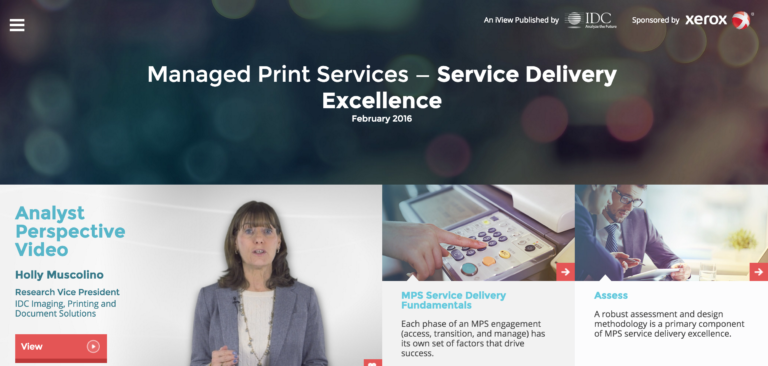Guest post by George Yeadon, General Manager, Advanced Consulting Services, Newfield NFIT, A Xerox Company
Have you had the Maturity discussion? We’re talking about the Maturity Model, and not every Managed Print Services (MPS) vendor will be able to have this conversation with you. But they should.
The purpose of a Maturity Model survey is to determine the relative position of an organization against a standard framework of managed print services. It establishes a baseline understanding of where you are in the MPS journey. Subsequent updates can indicate progress or lack of it over time. You can also see benchmark information about a competitor or industry for comparison. The Maturity Model uses your position to open a dialog with your vendor partner about priorities, investments and deeper investigations leading to further improvements and business process transformation.
How Often Should You Do This?
We suggest that this maturity assessment be performed at least annually, and it should be free of charge from your MPS vendor. Practically speaking, a company’s Maturity Model should be re-evaluated annually around the same time your strategic plan is reviewed and updated. Staying current with your overall strategy maintains the framework for change within your organization.
Some hardware vendors do conduct assessments, including interviews of business process owners and stakeholders, but the Maturity Model is different and deeper. The Xerox MPS Maturity Model explores the current state and the aspirational goals of an enterprise. It tracks 18 dimensions in three segments: hardware-related, network and infrastructure-related, and policies and procedures-related. Feedback is captured for six core customer values: Cost Savings, Sustainability, Security, Mobility, Productivity and Insight. Each resultant profile should be measured against your goals for each of the core values and comparison to other companies in your industry. The latest findings can be presented during Quarterly Business Reviews (QBRs) with your MPS vendor.
What If You Don’t Have MPS?
The MPS maturity assessment can be used just as effectively with enterprises that have no MPS contract or are already engaged in one, even with a competitor to your current vendor. For non-MPS clients, the assessment shows the potential value of Managed Print Services to their business.
Existing MPS customers can see how their organization has matured and realized value from MPS. You’ll identify areas where traction was already achieved, either with your current MPS vendor, a competitor or on your own. The MPS account team should work with you to identify areas where challenges may exist. This helps your vendor recommend solutions for those particular problems. This lays the groundwork to build a custom roadmap reflecting areas of focus to achieve the next level of benefits.
What the Discussion Covers
The survey starts with a structured, face-to-face discussion with your vendor account team. Be prepared to talk about print policies, network management, tangible and intangible assets, even disaster recovery. They will review all aspects of your office print environment, including procurement, device management, mobility, filing and content management strategies.
Going through this exercise gives your MPS vendor an in-depth understanding of your values and challenges. Because the survey is structured around specific topics, it consistently captures details not typically obtained during other routine conversations. When representatives from different areas of your organization get involved — C-level, IT, procurement, finance, facilities — you gain additional perspectives.
Shining the Light on Priorities
The strategy of a Next Generation MPS vendor is to help clients go deeper into their own unique Maturity Model. Each survey finding can be probed further to determine its priority or importance within the strategy of your company, eventually leading to other possible solutions and ultimately some form of enterprise content management (ECM).
It’s a descriptive, rather than prescriptive exercise, capturing where you are in your current state view. It also begs the question — what is the strategic endpoint for your company? There has to be some ultimate vision to bridge the gap between current and future state.
Some organizations use the completed maturity model to revisit their own strategic plans or create them if none exist. They also use this information for internal communication, goal setting and measuring progress toward their desired state.
When undergoing a maturity assessment, keep in mind that there is no right or wrong level of maturity. The goal is to clarify your current state and agree on the desired future state. The results aren’t set in stone, so you’re not committed to any plan of action. But knowing where you stand is an achievement in itself.



